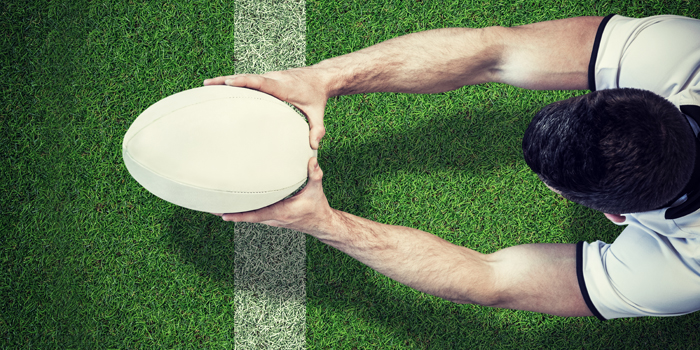
This season, I decided to take the year off. I am not afraid to admit that I needed it. I was suffering from a loss of confidence in my ability to do the job that I love. Were my methods not longer were worthwhile, are they still valid? I had so many questions to answer in my own head before I was ready to get back on the horse. So, I decided to take the year to write, do some speaking, clarify my own ideas to see the relevancy of them, and re-assess what I wanted to do.
Fortunately, the opportunity to do some consulting with a professional rugby team arose in a different country and competition, a different culture, a different language. It's a chance to try some new ideas and to add relevancy to my tried and tested methods. The players were very welcoming — sports people are good people, and it does not matter where they come from or what language they speak — they are there to get better every day and play the sport they love.
RECENT: The Physical Requirements That Make a Rugby Player Great
Part of my briefing when I undertook the consultancy was to look at the academy program and to make recommendations. Now, I am not an expert in Long-Term Athletic Development (LTAD) since I have always worked in the professional side of the business, but I have had quite a few discussions over the years with academy coaches of what type of player I would require moving into the professional team.
What I am about to write probably could be considered heresy in the strength and conditioning world, but what I found was that the academy program, like many around the world, was basically a strength and conditioning academy and not a rugby academy. Too much time was being spent on physical training and too little time being spent on rugby skills, professional development, psychological, technical, tactical skills.
I remember reading what the legendary Irish centre Brian O’Driscoll said once about academies that they were turning out physical giants that could not play the game. So with this in mind, and the thoughts of an old rugby league coach ringing in my ears, “If the kid is good enough, he is old enough,” but I want to make him ready enough to make the transition to a professional team.
This is the development program that I would recommend. I am discussing only the physical development aspects of the program, the majority of the program time should be rugby skills related, which I am not qualified to discuss in the same detail as the physical program.
Pre-Academy Level
- Stage 1/U15s: 1 x preparation physique per week
- Stage 2/U16s: 2 x preparation physique per week
Academy Level
- Stage 3/U18s: 3 x preparation physique per week
- Stage 4/U22s: 4 x preparation physique per week
Stages 1 and 2 Developmental Focus
- Primal movement patterns
- Mobility drills
- Core weight training movements
- Running technique
- Conditioning games
Introduction of 7 Primal Movement Patterns
All movements are performed with bodyweight initially, progressing to medicine balls, dowel rods, then barbells and dumbbells, and progressive loading over time. At each progression, the key technique criteria all have to be checked off before any progression is made.
RELATED: Key Components of a Youth Athlete's Initial Training Program
- Squat
- Hinge
- Lunge
- Push
- Pull
- Single leg
- Rotation
Introduction of Weight Training Philosophy
Start with 1 work set of four movements, emphasis on technique before loading. Over the 4 weeks of each month build up an extra set per week and decrease reps each week:
- Week 1 – 1 x 12
- Week 2 – 2 x 10
- Week 3 – 3 x 8
- Week 4 – 4 x 6
4 Movements
- Lower Body Push
- Lower Body Pull
- Upper Body Push
- Upper Body Pull
Technique only with gradual increase in loading; spend 1 month on each movement
Lower Body Push
- Box Squat
- Front Squat
- Overhead Squat
- Split Squat
- Back Squat
Lower Body Pull
- Back Extension
- Deadlift
- Hip Thrust
- Romanian Deadlift
- Good Morning
Upper Body Push
- Military Press
- Incline Press
- Bench Press
- Dips
- Floor Press
Upper Body Pull
- Bench Pull
- Chin-Ups
- Yates Row
- Shrugs
- Bentover Row
Core
- Plank
- Pallof Press
- Lateral Plank
- Full Body Twist
- Wood Chop
The exercise selection list above is based on the majority of movements that I would want proficiency in from my professional players. Of course, there are many variations that can be used and it is not a complete and comprehensive listing but a guideline for development.
Stage 2 Weights (my thanks to Simon Thomas of the Crusaders for the presentation and ideas that are set up below from his previous work with the Canterbury ITM squad)
1 x Lower Body session (superset A1 and A2 together)

Triset B1, B2, and B3 together
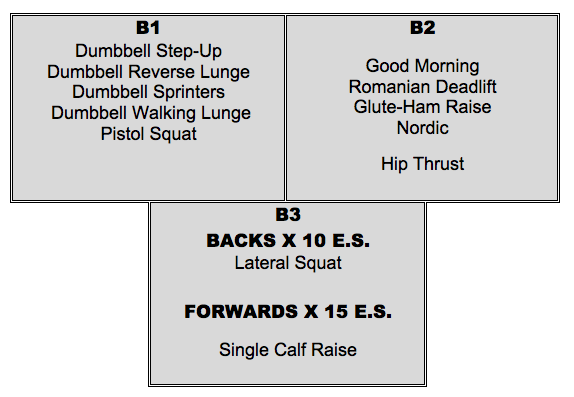
1 x Upper Body session (superset A1 and A2 together)

Triset B1, B2, and B3 together
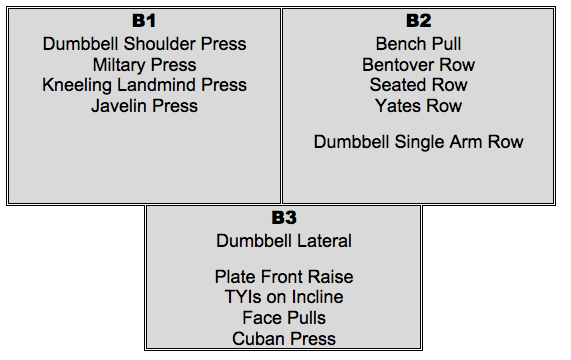
Introduction to Explosive Training and Olympic Movements
Jumps
- Knees to Feet
- Seated to Box
- Tuck Jumps
- Borzov Hops
- Box Jumps
- Depth Jumps
Upper Body Plyometrics
- Clap Push-Ups
- Medicine Ball Crossover Push-Ups
- Medicine Ball Throw Against Wall
- Medicine Ball Drops
- Push-Up Jumps
- Rebound Push-Ups
Medicine Ball Throws
- Chest Pass
- Single Arm
- Scoop Toss
- Rotational
- Over Head
Teaching Progressions with Empty Bar
A: Muscle Snatch from Floor + Hang Power Snatch + Snatch Balance + Squat Snatch Press + Overhead Squat + Simmons Good Morning (3 sets)
OR
B: Clean Grip Power Snatch + Hang Power Clean + Sots Press + Squat Press + Front Squat (3 sets)
Choose 3 couplets each session from the following list (3 x 5 reps).
Movement couplets can be done as teaching progressions as well as for specific warm-ups prior to a lifting session and even as finishing movements to reinforce technique. I have even used them with appropriate loading as workouts themselves since by selecting 3 or 4 of the couplets, you can effectively train the entire body.
- Sots Press + Squat Military Press
- Pressing Snatch Balance + Snatch Grip Squat Press
- Squat Clean + Front Squat
- Clean Grip Power Snatch from Low Blocks + Push Press
- Power Snatch + Push Press Behind Neck
- Power Clean + Push Press
- Power Snatch + Step-Up
- Squat Snatch + Overhead Squat
- Push Press + Split Jerk
- Hang Power Clean + Hang Squat Clean
- Hang Clean + Romanian Dead Lift
- Split Jerk + Split Squat
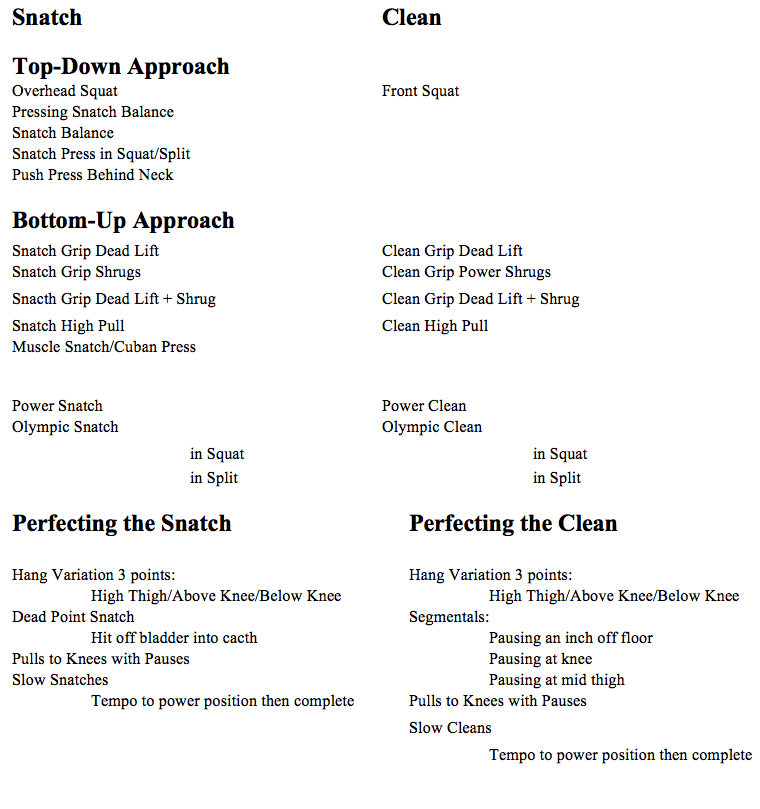 Players must first complete a 6-week education period three days a week on the movements mentioned in Stage 3 introduction. Continue with weights program similar to Stage 2 and add a Power Day.
Players must first complete a 6-week education period three days a week on the movements mentioned in Stage 3 introduction. Continue with weights program similar to Stage 2 and add a Power Day.
Complete A1 on its own — Quality Focus:
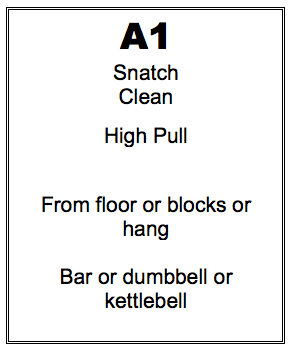
Superset B1 and B2 together:

Superset C1 and C2 together:

Metabolic (4 sessions per week)
Follow the professional program as designed by the lead strength and conditioning coach of the professional team that the academy is connected to. Below is the professional team weight training program that was utilized during this season pre-season program.
Session 1 (Beast Circuit):
- Deadlift
- Power Clean from Hang
- Front Squat
- Push Press
- Bentover Row
- Romanian Dead Lift
- 750m Row or 2km Watt Bike x 6
Session 2 (Full Body Strength): 6 x 6 Step Load working up to a 6RM
- 1 x Lower Body Push
- 1 x Lower Body Pull
- 1 X Upper Body Push
- 1 X Upper Body Pull
Session 3 (Strongman Circuit):
- Trap Bar Overhead Walk, Tire Flip, Kettlebell Windmill
- Prowler Push, Hang Clean and Push Press with Power Bag, Suitcase Deadlift
- Sled Drag, Walking Lunge with Power Bag Overhead, Half Turkish Get-Up
- Farmer’s Walk, Power Ropes, Plate Sit-Up
Session 4 (Otago Circuit):
- Row 300m in <1 minute
- 10 Full Burpees
- 10 x 36kg 2-Arm Swing with Kettlebell
- 10 x Reverse Lunge each leg
- 10kg Medicine Ball Slams to ground 10 each side x 8
Power Group: 2 sessions per week Power, 1 x Full Body Strength
Choose 1 exercise from each category:
- (1a) Power Snatch or Power Clean or Trap Bar Jump Shrug or Rack Pulls
- (1b) Week 1: Long Jump
- Week 2: Repeat Hurdle Jumps
- Week 3: Box Jump-Ups
- (2a) ¼ Explosive Squat or Band Box Squat or Step-Up
- (2b) Week 1: Bench Blasts
- Week 2: Repeat Hurdle Hops
- Week 3: Borzov Hops
- (3a) Push Press or Band Bench or Split Jerk
- (3b) Week 1: Medicine Ball Drops
- Week 2: Clap Push-Ups
- Week 3: Plyo Rebounds
+ 1 x Upper Body Push superset Pull after each session

Full Body Strength
- 1 x Squat or Single Leg exercise
- 1 x Hamstring/Lower Back
- 1 x Upper Body Push superset with 1 x Upper Body Pull

Strength: 4 sessions per week, full body strength
- 1 x Squat or Single Leg exercise
- 1 x Hamstring/Lower Back
- 1 x Upper Body Push superset with 1 x Upper Body Pull

1 x Power
Choose 1 exercise from each category:
- (1a) Power Snatch or Power Clean or Trap Bar Jump Shrug or Rack Pulls
- (1b) Week 1: Long Jump
- Week 2: Repeat Hurdle Jumps
- Week 3: Box Jump-Ups
- (2a) ¼ Explosive Squat or Band Box Squat or Step-Up
- (2b) Week 1: Bench Blasts
- Week 2: Repeat Hurdle Hops
- Week 3: Borzov Hops
- (3a) Push Press or Band Bench or Split Jerk
- (3b) Week 1: Medicine Ball Drops
- Week 2: Clap Push-Ups
- Week 3: Plyo Rebounds

- 1 x Upper Body Strength
- 1 x Primary Upper Body Push
- 1 x Primary Upper Body Pull
- 1 x Secondary Upper Push superset 1 x Secondary Upper Body Pull

- 1 x Lower Body Strength
- 1 x Squat
- 1 x Single Leg exercise
- 1 x Hamstring/Lower Back
- 1 x Hamstring

Size Options:
- Triple Angle Drop Dumbbell Bench Press (45-, 30-, 15-degrees incline bench): 6 x 5/5/5; superset Mechanical Advantage Pulling Complex (bentover row/Yates row and/or shrug): 6 x 5/5/5
- Bradford Military Combo: 5 x 10; superset Mechanical Advantage Chin-Up Complex (pronated wide grip/neutral grip/supinated grip at shoulder width): 5 x 5/5/5
Multi-Press Complex (same weight throughout; 5 x 5 on each)(Thibadeau)
- Seated Muscle Snatch
- Seated Snatch Grip Press Behind Neck
- Seated Clean Grip Press Behind Neck
- Savickas Military Press (seated on floor with legs straight out)
- Standing Bradford Press
- Standing Push Press
- 1 and ½ Trap Bar Shoulder Press: 5 x 10; superset TRX Horizontal Rows: 5 x max
- Cuban Press; superset Overhead Shrug: 3 x 12
- 3 Way-Shoulder Raise (Dumbbell Lateral Raise/Plate Front Raise/Dumbbell T-Raise): 3 x 12; superset Renegade Row: 3 x 10 each side
Conditioning Elements of the Program
I am going to state another heresy here: I believe that early specialization on running methods is detrimental for the long-term progress of the rugby player. I believe in a wide range of games and movements before the intensity of specific aerobic and anaerobic conditioning options are introduced into the program.
That’s why there is a development of activities leading through the academy ages into the professional team sessions. I also believe that having these age groups partaking in other sports like basketball, water polo, wrestling, judo, volleyball, and handball will show skill and conditioning improvements over time that flow well into later age group-specific training for rugby.
Introduction of Mobility and Movement Drills
Ladders
Straight
- 1 foot in each space
- 2 feet in each space
- Ickey Shuffle
- Ickey Shuffle with a wide step; plant the landing
- 2 feet in and 2 feet out
- Lateral Jumps: 1 foot in and 1 foot out
- 2 feet jumps in each space
- Side Reach: Left and right
- Dead Leg Run-Through
- Single-Leg Hop in each space
Side On
- 2 feet in each space
- 1 foot in each space
- Carioca
- 2 in and 2 out
- 2 feet jumps in each space
- Single-Leg Hop in each space
Hurdles
- (Micro, mini, high)
- (March, skip, run)
Straight
- 1 foot run in each space
- 2 feet run in each space
- 2 feet jump in each space
- Single-Leg Hop in each space
- Dead Leg Run
Side On
- 2 feet in each space
- 1 foot in each space
- Single-Leg Hop in each space
Partner Speed Drills
- Tall, fall, and run
- Body lean, release, and sprint
- Body lean, resist, release, and sprint
- Body lean, resist, release, and race
- Body lean, resist, release, race, tag, turn, and race back to start
- Horse and cart drill
Wrestle Drills
- Pummel
- Arms through and grab
- Face slap
- Push up arm slap
- Rip the ball away
- Kneeling start and pin
- Commando crawl with player holding legs
- Chest to chest start position
- Back to back sitting on the ground start position
Movement Drills
- High Knees Run
- Butt Kick Run
- Power Skip
- Side on Skip
- Backward Run, reach the back leg out
- Hurdle Walk/Skip, forward and backward
- Lunging
- Forward
- Backward
- Lateral
- Diagonal
- Bear Crawl
- Alligator Crawl
- Frog Jump
- Monkey Run
- Basketball Slide
- Carioca/high-step option
- Bound
- Shoulder Rolls
- Knees to feet jumps
- Repeat hops for distance
- Repeat hops for height
- Repeat jumps for distance
- Hindu Push-Ups
- Inchworm
- Mountain Climber
- Grasshoppers
- Scorpion, face up and face down
- Leg Swings, forward and back, side to side
- Cat to Camel
- Single-Leg Sprinter on hands and knees
- Single-Leg Circles
- Lateral Knee Lift on all fours
- Rainbows, lying on your back
- Scissor Legs, lying on your back toes, touch the ground
- Single-Leg Romanian Deadlift + lunge
- Squat to stand
- Bosch Squat to lunge
- Rock and Rolls
- Prisoner Jump Squats
Fun Games
- 10 Pass
- Pad Bash
- Pac-Man
- Predator and Prey
- Chain Tag
- Rob the Nest
- Stuck in the Mud
- Get the ball across the field by running or passing against the same number of opposition players, best from 5 attempts
- Rats and Rabbits
- Numbers Drill
- Hats and Buckets
- Duck, Cow, and Sheep
Pass Races and Drills
- Across the field
- Lengthways
- Alignment off of 50m line
- Pop and spread full-field fan
- 10m line to try line (over and back twice going toward try line; then over and back once coming back to 10m line; race or for time)
- Short/long in 4s between the 10m lines
- Zig-zag in 10m channel then across the field, attacking goal line and passing back
- Zig-zag for time or distance, then leapfrog back to start
- Relays with the ball, various
- 2-on-1, 3-on-2, and/or 5-on-3
- Rectangle: 2 defend 3, facing each other
- Coloured cone passing drill: 2 teams facing each other
- Half-field 5-on-3: Attack from halfway
- Rapids coach calls a number and that number goes into first receiver
- 2-on-1 continuous
- Pass and support
- Mick Byrne Tail Gunner passing drill
Skill Drills and Games
- 4-on-2 constant attack for 1 minute (can be 6-on-3)
- 2 squares: 4-on-3
- Defensive square
- Numbering drill
- Numbers drill
- Peripheral vision drill
- Highlanders drill
- Roll ball, start 2-on-1, 3-on-2, and 5-on-3
- Malcolm Pad drill upfield
- Drop-out touch
- Strauss’ 3-on-2
- Eddie’s 5-on-3
- Bronco Ball
Rules for Anaerobic and Skill Games
Goal Line “D”
Attackers have 2 extra players than defenders.
The attacking team starts 5m away from goal line place another cone 2m out from goal line. The defenders cannot move out past this cone. Attackers have to run across the line to score. They do not have to ground the ball.
If an attacker is tagged (2-handed) the ball is passed back to the 5m line to start the next attack. Attackers have 2 minutes to score as many points as possible. Any time the ball is dropped, knocked on, and/or passed forward, that attacking raid is finished, and the ball has to go back to the 5m line to go again.
Offside Touch
The first pass must always go back then attack to the furthest try line. The attacking team gets 2 touches. After 2nd touch turnover, the ball can be passed after the restart pass in any direction to ensure everyone is working all the time. All of the attacking team must be inside the 22m area before the try can be scored. The team that scores retains possession.
The defending team must push inside the attacking halfway line; otherwise, the try is worth 2 points.
Another version is man-on-man, where you can only tag your partner and vice-versa, plus you can add a sweeper that can tag anyone as well. Can be played as a kicking game. Grubber kicks only. No running with the ball post-reception of the grubber kick.
Speed Ball
Played with a soccer ball. Normal soccer rules apply, but if you can catch the ball on the full, you then play on for 3 touches with normal touch-football rules.
Applying after the 3rd touch the ball is dropped and neither the defender nor the attacker involved in that last play is allowed to touch the ball.
The same rule applies for forward pass or knocked on ball. Play on the full field.
One Touch
Best played across the field. The 50m line to try line are now sidelines. Both teams start on the sidelines (now try lines) with one in possession and the other being defenders. Normal touch rules apply.
Attackers only get one play when touched. They all have to sprint back to their respective try line before they can push up in D. The new attacking team must pass once from the breakdown and then play continues in the same fashion.
Upon a try being scored, the scoring team stays in possession, and both teams swap side and restart from the try lines.
Drop Off Touch
Normal touch rules apply, other than when a person makes a touch he has to sprint around his own goalposts before being eligible to be on D again, attacking team gets 6 touches, no kicking is allowed.
Cone Ball
Set up the field with cones on the junction of the 22m both ends and the 50m lines. With the 5m lines, this is when you are playing on the full field playing across the field.
- Variation 1: Ball must be passed backward at all times, you get 2 touches and then have to hand the ball over. You can grubber to yourself and to other players once per possession. The player can be offside.
- Variation 2: Ball can be passed in any direction, you get only 1 touch then it is a turnover, you can grubber kick to another player, but not yourself one time only per possession; however, that player can be offside.
- Variation 3: Ball can be passed in any direction, a chip kick or kick pass can be used during the possession, you get only one touch before turnover. If the ball bounces, it is an immediate turnover.
Scoring is as follows:
- If you run the ball in and put it down on a cone: 5 points
- If you score other than putting the ball on a cone: 3 points
- If you receive a grubber kick in the scoring area: 1 point
Coconut Touch
Normal rules of touch football apply. Six touches then turnover. No kicking allowed. Within the set of 6, you are allowed one forward pass, but you cannot score off of that forward pass without one more legal pass being played.
Coconut Kick Option Touch
As per above, but instead of a forward pass, you can have an offside kick reception. If it is caught, play on from that tackle. Cannot score from the kick without having at least one more pass.
Yellow Bib Touch
Normal touch rules apply, but 2 members on the attacking team wear yellow bibs. They cannot be touched and they cannot score. Three passes after a yellow possession must be executed before a try can be scored. Team attacks for 3 minutes. The number of tries is tallied, then the roles are reversed.
2 Games
Two games are being played at the same time: One length ways goal line to goal line and one across ways, sideline to sideline. This can be the same game or different; it’s up to you.
Normal touch lengthways and killer pop touch sideways works very well. Builds great vision. Divide the group into 4 teams with 4 different coloured bibs on.
Long/Short
Play any of the games of touch variations that have long ways (goalpost to goalpost). When a try is scored, both teams must sprint around corner posts and then attack playing short (sideline to sideline) then when a try is scored both teams have to run through the posts at either end of the field and continue.
Channel Touch
Normal touch football rules apply, set of 6 tackles. Turn over after 6th ball rolled between the legs to start play after a tackle is made. One-hand touch, no running on, the defense must get back, if you are called offside, you can not make a touch.
Scoring is as follows:
- Scoring in the 5m channel: 5 points
- Scoring in the 10m channel: 3 points
- Scoring anywhere else: 1 point
Freeze Defense
Normal touch rules apply but no one can stand in the channel made by the goalposts. If the ball is passed across this channel, any number of defense is frozen on that side of the posts for 1 or 2 touches. Any number of additional attacking players can come into that side of the field.
As soon as 1 or 2 touches have been made, the game returns to normal. Play on. Six touches, then turn over.
Drop Out Touch
Three defenders drop kick the ball out from under the crossbar; 12 attackers receive and have 6 tackles to score a try. Normal touch rules apply. Whoever scores the try stays on defense, and they drop-kick the ball out to re-commence play. Continue until the attacking team cannot score a try in 6 tackles.
Circle Touch
Offside touch variation. Have 3 or 4 different coloured cone circles in various positions around the designated playing area. The objective is to run the ball into a circle.
No defender or attacker is allowed to stand in a circle, but an attacker can jump into the circle as he is receiving the ball. Once you have attacked 1 colour, you must then attack another. You cannot go back to the same coloured circle. One touch only, then turn over.
If it is a turnover, the new attacking team cannot go to the circle that the previous attacking team was heading toward.
As a bonus, if a team can go to all 4 coloured circles in a row without going back to a colour they have already been to, they score a bonus 4 points for a Grand Slam. Each circle is worth 1 point.
Pop Ball
Play up and downfield. When touched or stopped, the attacker must pop the ball up from the ground or whilst going to ground. The attacking team has 3 touches before the game changes to Fijian touch (2 different opposition must touch the ball carrier. The attacker cannot score if he has been touched once). The attacking team has the option to kick, but only when Fijian touch is being played.
A free-kick is given against the infringing team. The infringing team must retreat to the 22m line if inside their half or retreat to the 50m line if in opposition half before defending can start.
Any time the ball goes out of play, the ball can be thrown in a straight line or toward their goal line.
- Variation 1: Team retains possession after scoring and attacks the opposite direction
- Variation 2: When a free kick is given the attacking team must pass twice (2 passes) before attacking
Force Back Game Rules
Kick off from own 22m line. If you catch the ball on the full, you can:
- Play on by running and passing for one touch then turn the ball over to the opposition who kick to re-start; or
- Take 5 full running steps forward and kick again.
If you attempt to catch the ball on the full and knock it forward, the opposition takes possession at that point. If you attempt to catch and knock the ball backward or sideways, you take the ball back 5 running steps and kick from there.
If a kick goes out on the full from outside, your own 22m the opposition takes over possession from where the ball was kicked. If kicked out on the full from inside your own 22m, you retain possession from where the ball goes out.
If you bounce the ball before it goes out from anywhere on the field, you maintain possession from where it went out.
Scoring:
- 5 points for a try
- 3 points from a drop goal
- 2 points from a kick that lands in the goal on the full
- 1 point for a kick that runs into the in the goal
Introduction of Aerobic and Anaerobic Running
Off-Feet Conditioning
I have detailed many of these types of programs in previous articles here at elitefts.com, but here is a complete plan of a program that I have used previously with a professional club.
Running Plan
There will be 15 to 20 minutes of conditioning games for all groups before the specific plan for each group below:
Neural and Mechanical Groups
Monday (Repeat x 3)
- Standing Long Jump + 15m sprint
- 15m sprint, start on chest
- Standing Triple Jump + 15m sprint
- Resisted Harness 20m
- 3 x Long Jump + 20m sprint
- Heavy Sled Sprint: 20m
Wednesday (Repeat x 3)
- Short Bungee
- 10m sprint, Power Skip, 20m sprint
- Short Bungee
- 10m sprint, Speed Bound, 20m sprint
- Short Bungee
- 10m sprint, Zig Zag Bound, 20m sprint
Friday (Repeat x 3)
- Power Skip (5 each leg)
- Prowler Push Low Handles: 20m
- Bound (5 each leg)
- Flying: 30m with 10m lead-in
- Resisted Harness Release: 10-30m
- 20m sprint from crouch start
Metabolic Group
Monday
- Repeated Speed
- Week 1: 15 x 40/20
- Week 2: 20 x 30/30
- Week 3: 25 x 20/40
- Week 4: 10 x 20/40, 10 x 30/30, 10 x 40/20
Tuesday
Conditioning Games (15 minutes) and Wrestling 5 x 1 minute/30 seconds rest and 2 sets x 6 Malcolms, going every 5 minutes
Wednesday
VO2 Grids
- Week 1: 3 x 3 minutes @ 20/20 rest 1.5 minutes between sets
- Week 2: 3 x 4 minutes @ 15/15 rest 2 minutes between sets
- Week 3: 4 x 5 minutes @ 10/10 rest 2.5 minutes between sets
- Week 4: 2 x 5minutes/4 minutes/3 minutes @ above intensities and rest periods
Thursday
Conditioning Games (15 minutes) & Game Day Clean Out Drill 5 x 1 minute/30 seconds & 6 x AB Shuttle
Friday
- Shuttle Run Variations
- Shuttle Run: 20m out and back, 40m out and back, 60m out and back x 5 in less than 5 minutes
- 10 x Tietjens Shuttle: 80-60-40 drill in less than 30 seconds on the minute
- Start on goal line sprint to 22m touchline with foot, sprint back to 22m touchline with foot, sprint to far 10m, walk through to goal line
- Springbok Shuttle Run Test
Saturday
Super Circuit: 1km Intervals or 3-minute and 5-minute intervals
Follow the professional program as designed by the lead strength and conditioning coach of the professional team that the academy is connected to.
Below is a week out of the professional team's pre-season program to highlight the style of training that they would be doing.
Monday
- Placement Touch: 4 x 5 minutes with 2.5 minutes recovery/water/change-over
- Metabolic Group: Beastly x 8
Tuesday
- Circle Touch: 4 x 5 minutes with 2.5 minutes recovery/water/change-over
- Metabolic Extras: 8 x Single Bronco going every 2 minutes
- Metabolic Group: Full Body Strength 6 x 6
Wednesday
- Swim Conditioning: Swim underwater as far as you can on one breath, then pop up and finish the lap freestyle stroke, walk back recovery, no dive entry x 20
Thursday
- Fiji Touch: 4 x 5 minutes with 2.5 minutes recovery/water/change-over
- Metabolic Group: Strongman Circuit x 3
Friday
- Cone Ball: 4 x 5 minutes with 2.5 minutes recovery/water/change-over
- Metabolic Group: Otago Circuit x 8










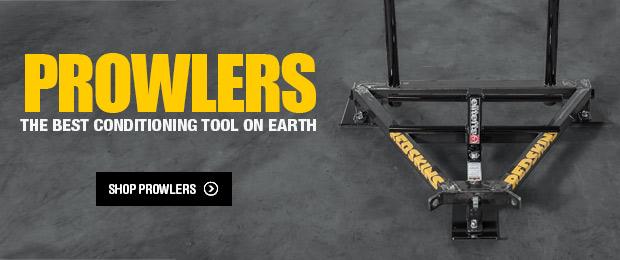
4 Comments